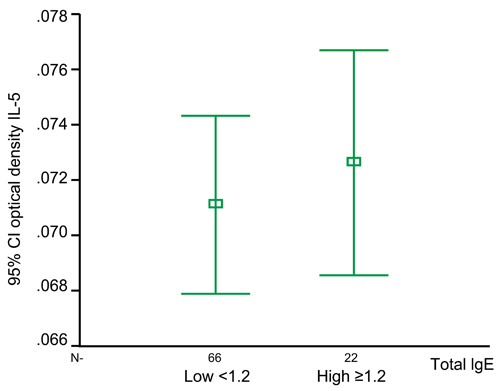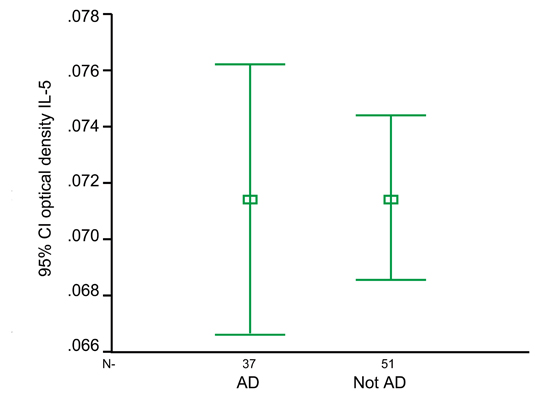Asia Pac Allergy.
2011 Jul;1(2):73-79. 10.5415/apallergy.2011.1.2.73.
The role of allergic risk and other factors that affect the occurrence of atopic dermatitis in the first 6 months of life
- Affiliations
-
- 1Department of Child Health, Cipto Mangunkusumo Hospital - Faculty of Medicine, University of Indonesia, Jakarta 10430, Indonesia. zakiudin.munasir@gmail.com
- 2Department of Internal Medicine, Cipto Mangunkusumo Hospital - Faculty of Medicine, University of Indonesia, Jakarta 10430, Indonesia.
- 3Department of Biology, Cipto Mangunkusumo Hospital - Faculty of Medicine, University of Indonesia, Jakarta 10430, Indonesia.
- 4Department of Dermatovenerology, Cipto Mangunkusumo Hospital - Faculty of Medicine, University of Indonesia, Jakarta 10430, Indonesia.
- 5Department of Clinical Pathology, Cipto Mangunkusumo Hospital - Faculty of Medicine, University of Indonesia, Jakarta 10430, Indonesia.
- 6Department of Child Health, Faculty of Medicine, University of Airlangga, Surabaya, Indonesia.
- KMID: 2397165
- DOI: http://doi.org/10.5415/apallergy.2011.1.2.73
Abstract
- BACKGROUND
Atopic dermatitis (AD) is a chronic inflammation of the skin that often appears in early childhood. The manifestation is related to the tendency towards T helper 2 cytokine immune responses (interleukin (IL)-4, IL-5). Genetic factors are suggested to play important roles in AD, and it can be transmitted to newborns, increasing their risk of developing allergies.
OBJECTIVE
To determine the association between cord-blood cytokine levels (IL-5, interferon (IFN) γ), cord-blood total immunoglobulin E (IgE) level, perinatal environmental exposure, and the risks of allergy as well as the development of AD in the first 6 months of life.
METHODS
A 6-month cohort study with a nested case-control within was conducted on newborns in Jakarta from December 2008 until May 2009. After the umbilical cord blood samples were taken and stored, subjects were followed up monthly until 6 months old. The occurrence of AD and lifestyle or environmental exposures were recorded. The allergic risk was determined using a modified pediatric allergy immunology work groups scoring system based on allergic history (allergic rhinitis, asthma, AD) in the family. The levels of IL-5 and IFN-γ were measured using ELISA and total IgE by CAP system FEIA. Multivariate analysis was used to evaluate risk factors.
RESULTS
This study was conducted on 226 subjects. The incidence of AD was 16.4%; of those, 59% had low risk allergy, 38.5% moderate, and 2% high risk. AD mostly occurred at the age of 1 month (57%). Cord blood samples were examined in 37 subjects with AD and 51 without AD; of those, 25% showed high levels of total IgE (>1.2 IU/µL), and 51% showed normally-distributed high absorbance IL-5 values (≥0.0715, absolute value was undetected). The increased level of IL-5 was directly proportional to IgE. High absorbance IFN-γ values (≥0.0795, absolute value = 18.681 pg/µL) were observed in 52% of subjects.
CONCLUSION
The associations between the risk of allergy in the family, cord-blood total IgE, IL-5, IFN levels, and some perinatal environmental exposure with AD in the first 6 months of life have not been established.
MeSH Terms
-
Allergy and Immunology
Asthma
Case-Control Studies
Cohort Studies
Dermatitis, Atopic*
Environmental Exposure
Enzyme-Linked Immunosorbent Assay
Fetal Blood
Humans
Hypersensitivity
Immunoglobulin E
Immunoglobulins
Incidence
Infant, Newborn
Inflammation
Interferons
Interleukin-5
Life Style
Multivariate Analysis
Rhinitis
Risk Factors
Skin
Immunoglobulin E
Immunoglobulins
Interferons
Interleukin-5
Figure
Cited by 2 articles
-
Early intervention in the management of atopic dermatitis
Donald Y.M. Leung
Asia Pac Allergy. 2011;1(2):51-52. doi: 10.5415/apallergy.2011.1.2.51.The management of food allergy in Indonesia
Zakiudin Munasir, Dina Muktiarti
Asia Pac Allergy. 2013;3(1):23-28. doi: 10.5415/apallergy.2013.3.1.23.
Reference
-
1. Wadonda-Kabondo N, Sterne JA, Golding J, Kennedy CT, Archer CB, Dunnill MG. ALSPAC Study Team. A prospective study of the prevalence and incidence of atopic dermatitis in children aged 0-42 months. Br J Dermatol. 2003. 149:1023–1028.
Article2. Halken S, Høst A, Hansen LG, Østerballe O. Effect of an allergy prevention programme on incidence of atopic symptoms in infancy. A prospective study of 159 "high-risk" infants. Allergy. 1992. 47:545–553.3. Strobel S. Dietary manipulation and induction of tolerance. J Pediatr. 1992. 121:S74–S79.
Article4. Prescott SL, Macaubas C, Holt BJ, Smallacombe TB, Loh R, Sly PD, Holt PG. Transplacental priming of the human immune system to environmental allergens: universal skewing of initial T cell responses toward the Th2 cytokine profile. J Immunol. 1998. 160:4730–4737.5. Croner S. Prediction and detection of allergy development: influence of genetic and environmental factors. J Pediatr. 1992. 121:S58–S63.
Article6. Hansen LG, Halken S, Høst A, Møller K, Østerballe O. Prediction of allergy from family history and cord blood IgE levels. A follow-up at the age of 5 years. Cord blood IgE. IV. Pediatr Allergy Immunol. 1993. 4:34–40.7. Bergmann RL, Edenharter G, Bergmann KE, Guggenmoos-Holzmann I, Forster J, Bauer CP, Wahn V, Zepp F, Wahn U. Predictability of early atopy by cord blood-IgE and parental history. Clin Exp Allergy. 1997. 27:752–760.
Article8. Ngamphaiboon J, Tansupapol C, Chatchatee P. Atopic risk score for allergy prevention. Asian Biomed. 2009. 3:121–126.9. Eller E, Kjaer HF, Høst A, Andersen KE, Bindslev-Jensen C. Development of atopic dermatitis in the DARC birth cohort. Pediatr Allergy Immunol. 2010. 21:307–314.
Article10. Michel FB, Bousquet J, Greillier P, Robinet-Levy M, Coulomb Y. Comparison of cord blood immunoglobulin E concentrations and maternal allergy for the prediction of atopic diseases in infancy. J Allergy Clin Immunol. 1980. 65:422–430.
Article11. Warner JA, Miles EA, Jones AC, Quint DJ, Colwell BM, Warner JO. Is deficiency of interferon gamma production by allergen triggered cord blood cells a predictor of atopic eczema? Clin Exp Allergy. 1994. 24:423–430.
Article12. Fälth-Magnusson K, Kjellman NI. Development of atopic disease in babies whose mothers were receiving exclusion diet during pregnancy--a randomized study. J Allergy Clin Immunol. 1987. 80:868–875.13. Mills CM, Srivastava ED, Harvey IM, Swift GL, Newcombe RG, Holt PJ, Rhodes J. Cigarette smoking is not a risk factor in atopic dermatitis. Int J Dermatol. 1994. 33:33–34.
Article14. Wang IJ, Hsieh WS, Wu KY, Guo YL, Hwang YH, Jee SH, Chen PC. Effect of gestational smoke exposure on atopic dermatitis in the offspring. Pediatr Allergy Immunol. 2008. 19:580–586.
Article15. Ustun S, Turgay N, Delibas SB, Ertabaklar H. Interleukin (IL) 5 levels and eosinophilia in patients with intestinal parasitic diseases. World J Gastroenterol. 2004. 10:3643–3646.
Article16. Malhotra I, Ouma J, Wamachi A, Kioko J, Mungai P, Omollo A, Elson L, Koech D, Kazura JW, King CL. In utero exposure to helminth and mycobacterial antigens generates cytokine responses similar to that observed in adults. J Clin Invest. 1997. 99:1759–1766.
Article



